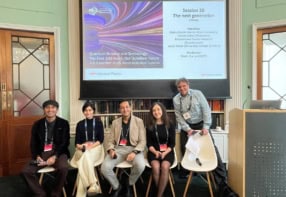Researchers in Germany and the UK are the first to entangle pairs of photons using a single atom. Their technique is based on an optical cavity containing one rubidium atom, and could provide a way to process information in a quantum computer (Sciencexpress DOI: 10.1126/science.1143835).

When two photons are entangled, the quantum state of one photon is revealed automatically by measuring the state of the other — a property that is crucial to the operation of quantum computers. Whereas ordinary computers use bits of information that are either 1 or 0, a quantum computer would use quantum bits of information, or qubits, that can be in a superposition of both 1 and 0 at the same time. A 1 could represent, say, a horizontally polarized photon, while 0 represent a vertically polarized photon. By combining N such qubits, these could entangled to represent 2N values at the same time, which would, in principle, allow a quantum computer to outperform a classical computer for certain tasks.
Some physicists believe that quantum computers could involve entangled photons moving from node to node in an optical system – with the nodes performing logical operations on the photons. In order for such a computer to work, it would need a way of transferring quantum information from the entangled photons to the nodes and vice versa. It would also require a way of generating entangled photon pairs and sending them off in the appropriate directions. Little of this technology is available today and hence quantum computation remains a distant dream.
Such nodes could consist of an atom trapped by a standing wave of light in an optical cavity. However, researchers have so far only been able to get such an atom to emit a single photon that is entangled with the atom itself. Now, however, Gerhard Rempe and colleagues at the Max Planck Institute for Quantum Optics in Garching, Germany and Axel Kuhn at the UK’s Oxford University, have extended this technique to use a single atom to create an entangled pair of photons.
The team first fired a laser pulse at a trapped atom, causing it to emit a single photon. As a result of this process, the atom and the photon are entangled. A microsecond or so later, a second laser pulse was fired at the atom, causing it to emit a second photon. Crucially, the second pulse cause the entanglement to be transferred from the atom to the second photon, and the two photons become an entangled pair.
Rempe told Physics Web that the photons could then be sent to interact with two different atoms. As a result of this interaction, the two atoms would become entangled with each other. This, he said, could form the basis of a “quantum repeater”, which is an essential component of a quantum computer.
According to Rempe, an important benefit of the scheme is that an entangled photon pair can be produced “at the push of a button”, unlike other methods, which create entangled pairs in random manner.
The researchers have managed to operate their scheme with a 1.3% probability that a photon pair is entangled. While this is on par with other entanglement schemes for quantum computing, the team is currently working to better localize the atom inside the cavity, which Rempe said will improve the efficiency of the system.


